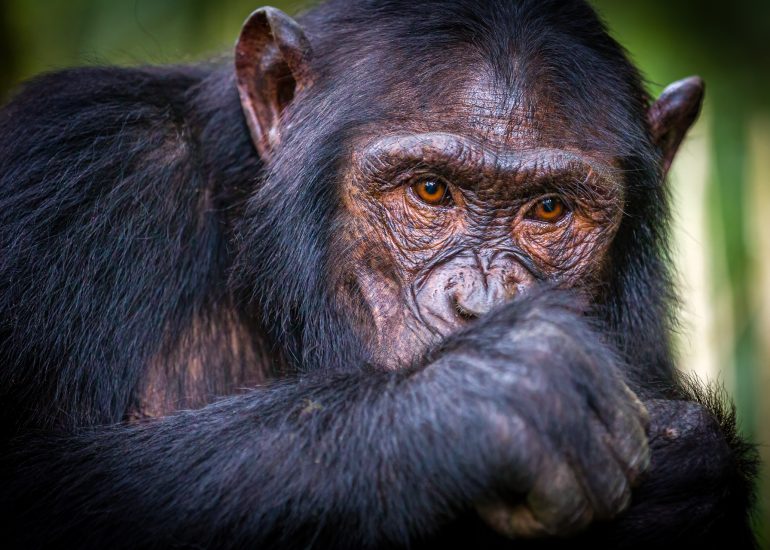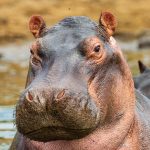Uganda
Journal
The Pearl Of Africa
Part 6
Day 14
From Ishasha to Bwindi Impenetrable via Lake Bunyonyi
The day starts with an extensive breakfast. Then we pack our things in the car and drive into the national park again in search of the tree climbing lions of Ishasha.
We drive almost 4 hours through the park and several times off all the striking trees on which the lions can usually be seen. Unfortunately without success. Nevertheless, we find fresh traces near a tree and we suspect that the lions are actually in the dense thicket. We wait for a while and then around noon we have to set off. 6 long hours are in front of us for only 200 km. That says a lot about our path today. And although we did not see the tree climbing lions, we had other nice encounters during our trip through Ishasha.
As we leave Ishasha and make our way towards Bwindi Impenetrable National Park, we decide to take a detour and pause at the breathtaking Lake Bunyonyi.
We are driving through villages and smaller cities again. In between we have to refuel and so we take a short break in one of the cities and watch the hustle and bustle around us for a few minutes.
Leaving the city we find ourselves surrounded by lush greenery. Tall trees line the sides of the road, creating a picturesque canopy overhead. The air is filled with the refreshing scent of nature, and we can’t help but feel a sense of tranquility wash over us.
The road meanders through the countryside, offering glimpses of local villages along the way as well as tea plantation. We pass by small houses with thatched roofs and vibrant gardens, where locals go about their daily activities. Children wave at us with big smiles, and we wave back, feeling a warm connection with the friendly locals.The scenery changes as we approach the rolling hills of the region. The landscape transforms into a patchwork of terraced fields, showcasing the hard work of the local farmers. We admire the dedication and effort that goes into cultivating these lands, and it fills us with a sense of admiration.
Lake Bunyonyi
As we ascend the hills, we catch glimpses of Lake Bunyonyi in the distance. The sparkling blue waters contrast beautifully with the surrounding greenery, creating a breathtaking sight. We can’t help but feel a surge of excitement as we get closer to our destination. The road begins to wind its way downhill, offering spectacular views of the lake. We can see the small islands scattered across the water’s surface, each with its own unique charm. The sight is nothing short of enchanting, and we’re in awe of the natural beauty that surrounds us.
We park our car and find a cozy café right by the lakeside, where we sit on the terrace, savoring our coffee. From here, we can observe the locals skillfully navigating their boats across the serene waters, adding to the charm of the scene.
Lake Bunyonyi holds several remarkable features that make it a unique and captivating destination. First to mention is the scenic beauty. Surrounded by lush green hills, the lake’s calm and crystal-clear waters reflect the stunning natural landscape, creating a picturesque setting that is often considered one of the most beautiful in Uganda. The peaceful ambiance is a strong contrast to the bustling cities and creates a serene atmosphere for visitors to relax and unwind. The lake is dotted with numerous small islands, over 20 in total, each with its own character and charm. These islands vary in size and offer diverse experiences, from uninhabited islets to islands with resorts, campgrounds, and even a school. The scenic beauty is enhanced by these islands, making boat trips around the lake a popular activity.
The lake is deeply rooted in the local culture of the surrounding communities. The name „Bunyonyi“ means „place of little birds“ in the local language, and the lake is home to a rich diversity of bird species. Some of the notable bird species you may encounter around the lake include:
- African Harrier-Hawk
- White-tailed Blue Monarch
- Grey Crowned Crane (Uganda’s national bird)
- African Fish Eagle
- African Darter
- African Jacana
- Hammerkop
- Pied Kingfisher
- Malachite Kingfisher
- African Pied Wagtail
These are just a few examples, as the lake and its surrounding areas are home to over 200 species of birds. The variety of habitats, including marshes, forests, and agricultural fields, contribute to the rich avian diversity found in the region. The area around the lake is also inhabited by the Batwa people, one of the indigenous tribes of Uganda, and their presence adds to the cultural significance of the region.
Lake Bunyonyi is known for its impressive depth and size. The maximum depth of the lake reaches approximately 44 meters (144 feet), making it one of the deepest lakes in Uganda. In terms of its total size, Lake Bunyonyi covers an area of about 61 square kilometers (23.6 square miles). Its elongated shape stretches for about 25 kilometers (15.5 miles) in length and varies in width, with the widest point being around 7 kilometers (4.3 miles).
Regarding swimming in Lake Bunyonyi, it is generally considered safe. The lake’s waters are generally calm and devoid of dangerous currents or aggressive wildlife. However, it is always advisable to exercise caution and be aware of your surroundings. It’s essential to follow any guidelines provided by local authorities or your accommodation regarding swimming safety, as conditions can vary. As with any natural body of water, it’s a good practice to swim in designated areas, be mindful of your swimming abilities, and take necessary precautions for your personal safety. Lake Bunyonyi is known to have a low prevalence of bilharzia (also known as schistosomiasis), compared to some other lakes in Uganda. However, it is still recommended to take precautions to reduce the risk of infection. Bilharzia is a parasitic infection caused by the Schistosoma parasite, which is commonly found in freshwater bodies where certain snails act as intermediate hosts.
The mountains surrounding Lake Bunyonyi add to the picturesque and captivating landscape of the area. These mountains are part of the larger Virunga Mountain Range, which stretches across the borders of Uganda, Rwanda, and the Democratic Republic of the Congo.
Our guide Innocent has another surprise for us. After he explained to us that he grew up nearby, we get a visit from his father, Christoph. Innocent and Christoph tell us how Christoph brewed beer in his younger years and Innocent reports about how he carried the beer across the mountain to the next place to sell it.
Of course after our coffee, we have a beer with Christoph before we set off again.
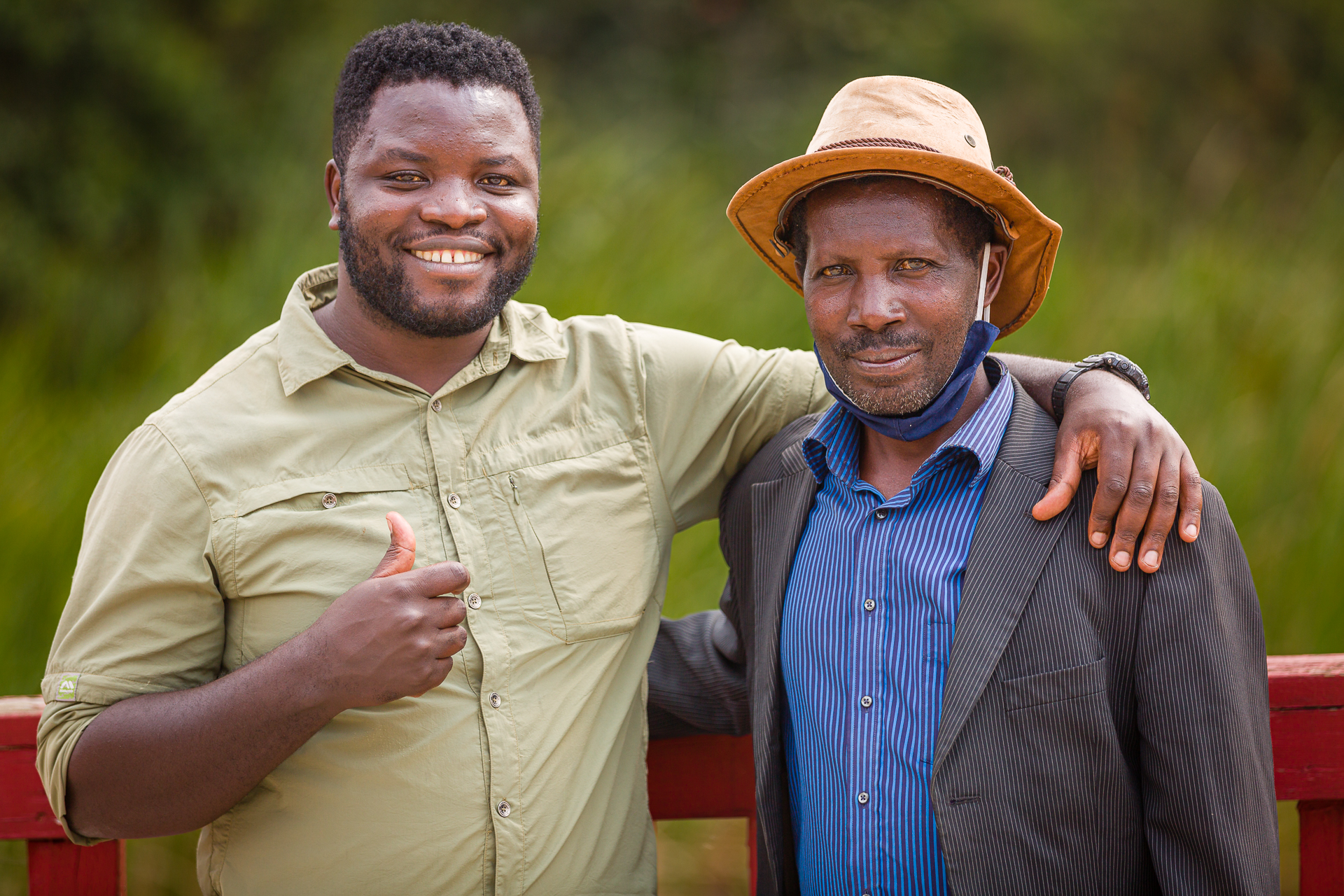
Innocent and Christophe
After our refreshing break, we continue our journey towards Bwindi Impenetrable National Park, traversing through the majestic mountains. The road, though scenic, proves to be quite challenging as it pretty much washed-out. We have to drive cautiously, carefully maneuvering through the washed-out sections, which slows our progress considerably.
Nevertheless, the drive remains a feast for the eyes. We pass by quaint villages nestled in the valleys, surrounded by lush greenery that enhances the natural beauty of the landscape.
After we arrive at our accommodation, we talk to a few other guests at dinner. Afterwards, we get acquainted with the Batwa People who came to sell souvenirs and perform some traditional dances. The evening is very entertaining and although we are very tired and we are suppose to get up very early the next morning we stay for a while and watch the singing and dancing performance.
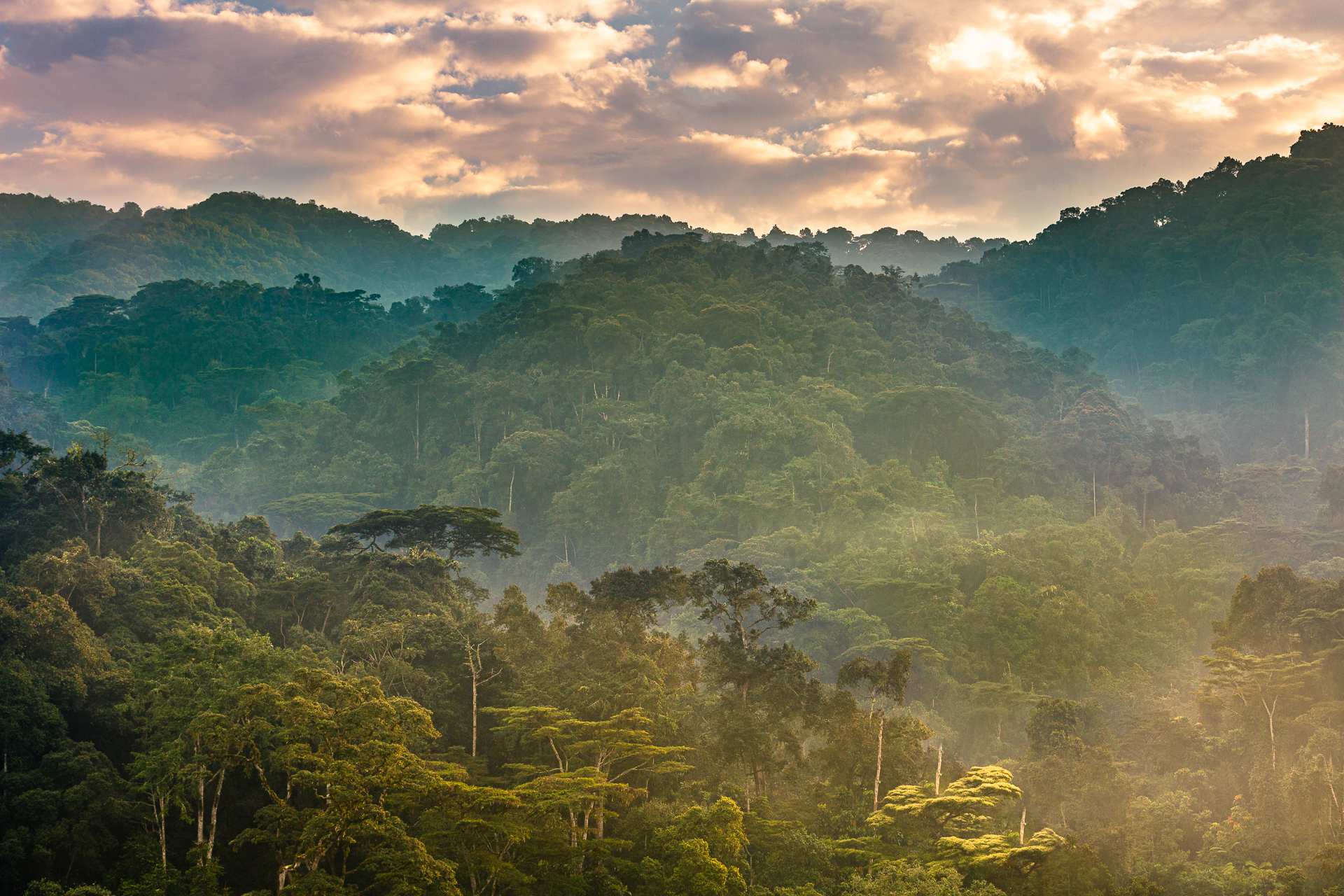
Bwindi Impenetrable Nationalpark
Day 15
Gorilla tracking in Bwindi Impenetrable Nationalpark
Let us take you on an exciting journey into the heart of Bwindi Impenetrable National Park, where one of the most captivating wildlife encounters takes place – gorilla tracking. Nestled in southwestern Uganda, Bwindi Impenetrable National Park is a sprawling sanctuary of dense rainforest, mist-shrouded hills, and an abundance of biodiversity. It is home to over half of the world’s remaining mountain gorilla population, making it a prime location for this awe-inspiring experience.
Our adventure begins early in the morning as the first rays of sunlight pierce through the forest canopy, casting a golden glow on the vibrant foliage. Accompanied by a team of expert trackers and armed rangers, we set off on a trek into the untamed wilderness. The hike is both challenging and exhilarating, as we navigate through tangled vines, and navigate steep slopes. The air is thick with anticipation and the sounds of the forest envelop us, with the calls of exotic birds and the rustling of unseen creatures creating a symphony of nature.
After a few hours of trekking, we receive word that a gorilla family has been located nearby. Our hearts quicken with excitement, and we pick up our pace, guided by the trackers‘ intricate knowledge of the gorillas‘ movements. As we approach the gorillas‘ habitat, we’re overcome by a sense of reverence. The forest falls silent, as if in deference to these majestic creatures. Through the dappled light, we catch our first glimpse of a massive silverback gorilla—a commanding figure with a backdrop of emerald foliage.
The gorilla family, consisting of females, juveniles, and adorable infants, goes about their daily routine, seemingly unperturbed by our presence. We observe in awe as they interact, play, and forage for food. The young ones showcase their curiosity, occasionally peering at us with wide, inquisitive eyes.
Our guide, a seasoned ranger, shares fascinating insights about each gorilla’s unique personality and family dynamics. We learn of their social structure, their communication through gestures and vocalizations, and their remarkable similarities to humans. When the group and especially the silver back become a little restless, the rangers intervene. They imitate sounds of the gorillas and it is almost as if the giants understand every word exactly. The silverback relaxes quickly and lets himself settle only a few meters from us in a bush and devotes himself again to food intake while behind him the teenagers of the group play in the trees.
Being in such close proximity to these gentle giants evokes a mix of emotions—respect, and a profound sense of interconnectedness with the natural world. We are reminded of the importance of preserving these endangered creatures and their fragile habitat. Our time with the gorillas is limited to ensure minimal disturbance, so we make the most of every precious moment. We capture the scene through our lenses, striving to immortalize their grace and power.
As we reluctantly bid farewell, the enormity of the experience settles within us. Another moment in life one will never forget. Being eye to eye with a silverback in their natural habitat still moves me to tears of joy.
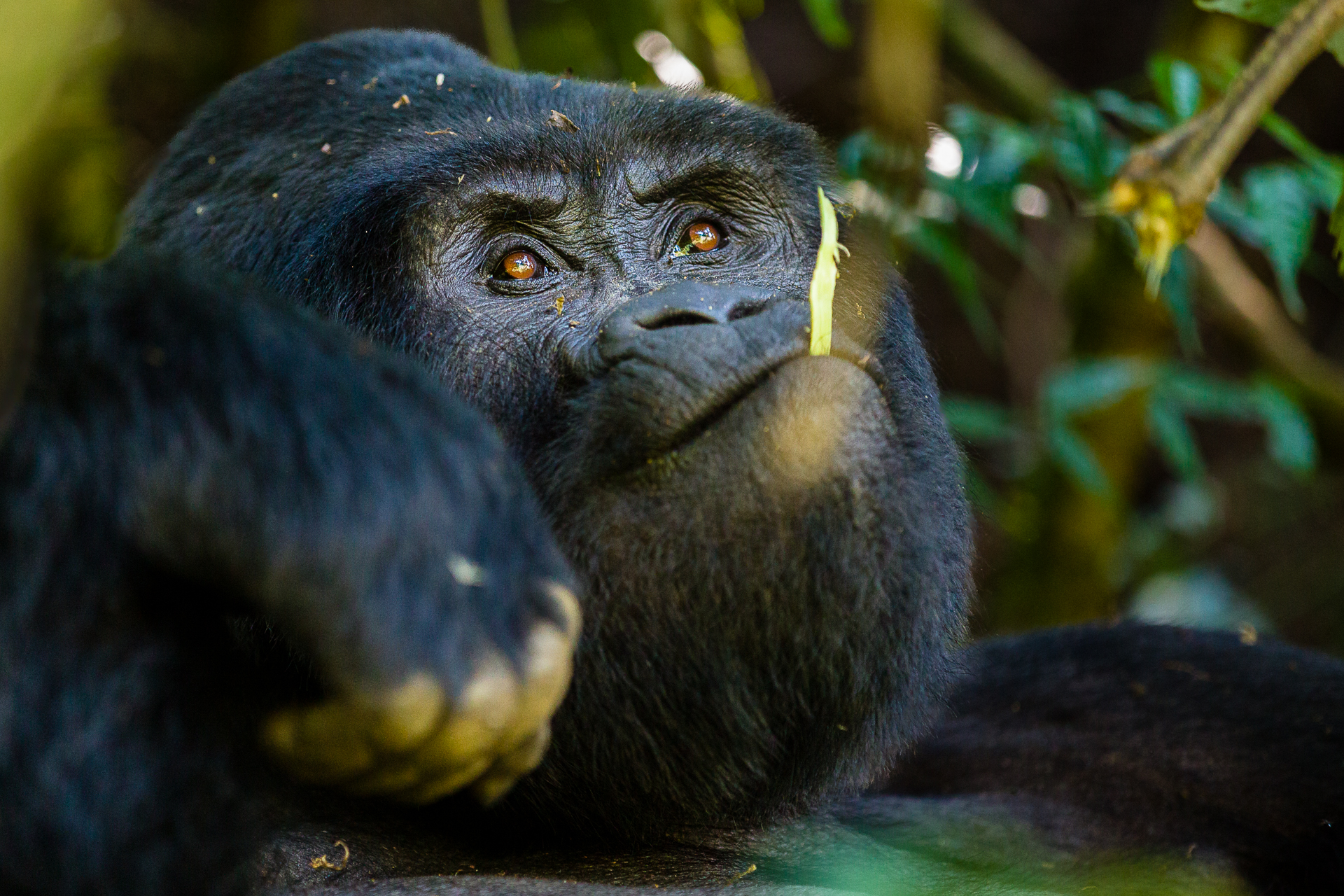
Mr. Mucunguzi – Silverback and head of the Family
About Mountain Gorillas
The mountain gorilla (Gorilla beringei beringei) is a subspecies of the eastern gorilla and is one of the two species of gorillas found in Africa, the other being the western gorilla. Here are some fascinating details about these magnificent creatures:
Mountain gorillas are the largest living primates, with males reaching heights of up to 5.6 feet (1.7 meters) when standing upright and weighing between 330 to 440 pounds (150 to 200 kilograms). They have a robust build with a thickset chest, long muscular arms, and a broad, domed head. One of their distinguishing features is a patch of silver hair on their back, which develops as they mature, hence the name „silverback.“ They are primarily found in the volcanic mountains of central Africa, inhabiting high-altitude forests at elevations of 8,000 to 13,000 feet (2,400 to 4,000 meters). Bwindi Impenetrable National Park in Uganda, Virunga National Park in the Democratic Republic of Congo, and Volcanoes National Park in Rwanda are key protected areas where these gorillas can be found.
They live in close-knit family groups known as troops or bands. A typical troop consists of a dominant silverback, several adult females, and their offspring. The silverback serves as the leader, protecting and maintaining order within the group. Mountain gorillas have a complex social structure and exhibit remarkable social bonds and interactions. These gentle giants are primarily herbivorous, with their diet consisting mainly of leaves, shoots, stems, and fruits. They are known to have a diverse palate, consuming over 100 different plant species. Due to their large size, they spend a significant portion of their day feeding to meet their nutritional needs.
Mountain gorillas are generally peaceful animals, with their demeanor often described as calm and gentle. They are primarily terrestrial but are capable climbers and occasionally build nests in trees. Gorillas communicate through various vocalizations, such as grunts, roars, and barks, as well as nonverbal gestures like chest beating, charging, and displays of dominance.
As it is well known they are critically endangered, with their population facing numerous threats. Habitat loss due to deforestation, illegal poaching, and civil unrest in their range countries have contributed to their decline. Conservation efforts, including protected areas, anti-poaching measures, and tourism regulations, have played a crucial role in their survival. Despite the challenges they face, mountain gorillas have become an emblematic species of conservation success. The tireless efforts of conservation organizations and local communities have helped stabilize their population, offering hope for their long-term survival.
Encountering mountain gorillas in their natural habitat is a profoundly moving experience, one that highlights the urgent need to protect these remarkable creatures and conserve their fragile ecosystems.
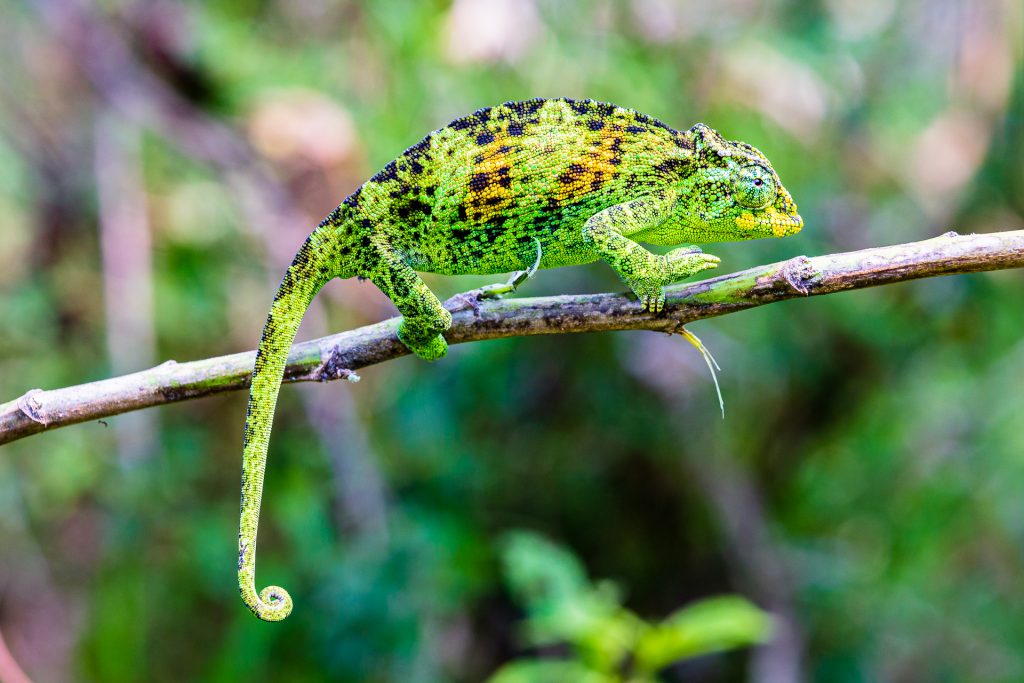
Chameleon
Chameleons
Happy to be satisfied, we drive back to our accommodation. The impressions of such a close encounter are still present today. Our journey will continue tomorrow and we will head towards Lake Mutanda. Nevertheless, we want to explore the surroundings a little in the afternoon and are lucky that a few locals draw our attention to chameleons sitting on the trees.
Jackson’s Chameleon (Trioceros jacksonii) is a well-known species of chameleon that is native to East Africa, including Uganda. Jackson’s Chameleon is known for its distinctive three-horned or tri-horned appearance.
The three horns on the head of male Jackson’s Chameleons are used for territorial displays and combat with other males. These chameleons are sexually dimorphic, meaning males and females have different physical characteristics. Besides the horns, they also have a prominent casque, or crest, on their heads. Females, on the other hand, generally lack horns and have a smaller casque.
Jackson’s Chameleons are arboreal reptiles that inhabit forests and wooded areas, often found in trees and shrubs. They are known for their ability to change color and are capable of displaying a wide range of hues, including green, brown, yellow, and even pink.
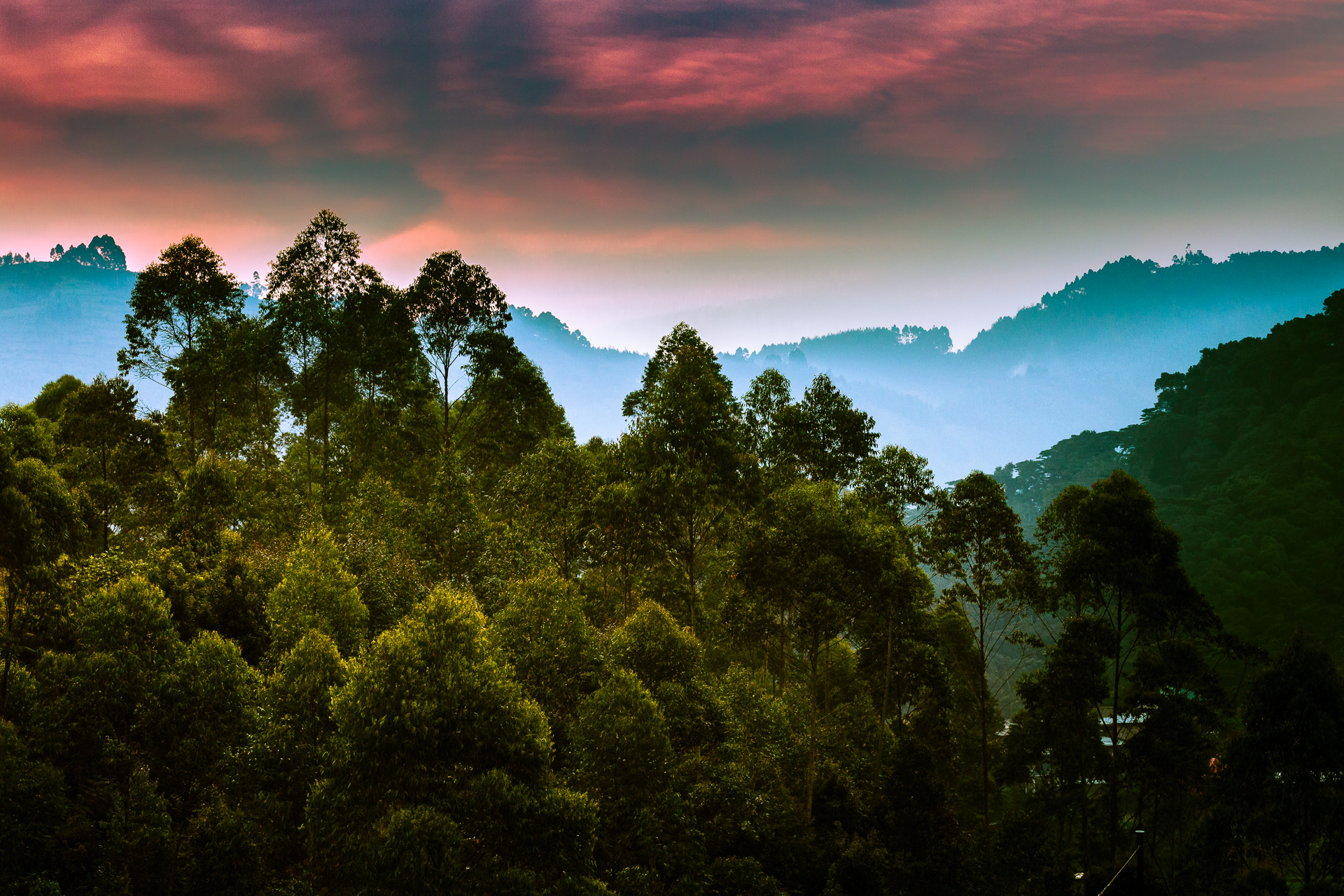
sunset in bwindi Impenetrable Nationalpark
As the sun began to dip below the horizon, our thoughts turned to the day’s highlight, the encounter with the magnificent mountain gorillas, who call this area their home. One couldn’t help but realize the fragility of their existence and appreciate the hard work of conservationists to protect them.
As the last rays of the sun disappeared over the horizon, it marked the end of an unforgettable day in the Bwindi Impenetrable National Park. The memory of the gorillas and the stunning sunset would linger long in the mind and heart, a reminder of the beauty and fragility of nature.
Portfolio
Uganda
"Africa has her mysteries, and even a wise man cannot understand them. But a wise man respects them" — Miriam Makeba
Birds Uganda
“Some birds are not meant to be caged, that's all. Their feathers are too bright, their songs too sweet and wild. So you let them go, or when you open the cage to feed them they somehow fly out past you. And the part of you that knows it was wrong to imprison them in the first place rejoices, but still, the place where you live is that much more drab and empty for their departure.” ― Stephen King, Rita Hayworth and Shawshank Redemption
Wildlife Uganda
“The more you learn about the dignity of the gorilla, the more you want to avoid people.” - Diane Fossey



